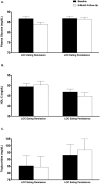Remission of loss of control eating and changes in components of the metabolic syndrome
- PMID: 29607525
- PMCID: PMC6002918
- DOI: 10.1002/eat.22866
Remission of loss of control eating and changes in components of the metabolic syndrome
Abstract
Objective: Pediatric loss of control (LOC) eating prospectively predicts the worsening of metabolic syndrome components. However, it is unknown if remission of LOC eating is associated with improvements in metabolic health. Therefore, we conducted a secondary analysis of a trial that enrolled adolescent girls with LOC eating, examining whether LOC remission (vs. persistence) at end-of-treatment was associated with changes in metabolic syndrome components at 6-month follow-up.
Method: One hundred three adolescent girls (age 14.5 ± 1.7 years; BMI-z 1.5 ± 0.3; 56.3% non-Hispanic White, 24.3% non-Hispanic Black) with elevated weight (75th-97th BMI %ile) and reported LOC eating were assessed for metabolic syndrome components at baseline and again six months following the interventions. The main effects of LOC status at end-of-treatment (persistence vs. remission) on metabolic syndrome components (waist circumference, lipids, glucose, and blood pressure) at 6-month follow-up were examined, adjusting for baseline age, depressive symptoms, LOC frequency, fat mass, and height, as well as race, change in height, change in fat mass, and the baseline value of each respective component.
Results: Youth with LOC remission at end-of-treatment had lower glucose (83.9 ± 6.4 vs. 86.5 ± 5.8 mg/dL; p = .02), higher high-density lipoprotein cholesterol (50.3 ± 11.8 vs. 44.8 ± 11.9 mg/dL; p = .01), and lower triglycerides (84.4 ± 46.2 vs. 96.9 ± 53.7 mg/dL; p = .02) at 6-month follow-up when compared with youth with persistent LOC, despite no baseline differences in these components. No other component significantly differed by LOC eating status (ps > .05).
Discussion: Reducing LOC eating in adolescent girls may have a beneficial impact on some components of the metabolic syndrome.
Trial registration: ClinicalTrials.gov NCT00680979.
Keywords: adolescents; loss of control eating; metabolic syndrome; obesity; overweight.
© 2018 Wiley Periodicals, Inc.
Figures

References
-
- Agudelo GM, Bedoya G, Estrada A, Patino FA, Munoz AM, Velasquez CM. Variations in the prevalence of metabolic syndrome in adolescents according to different criteria used for diagnosis: which definition should be chosen for this age group? Metab Syndr Relat Disord. 2014;12(4):202–209. doi: 10.1089/met.2013.0127. - DOI - PubMed
-
- Ambrosini PJ, Metz C, Bianchi MD, Rabinovich H, Undie A. Concurrent Validity and Psychometric Properties of the Beck Depression Inventory in Outpatient Adolescents. Journal of the American Academy of Child and Adolescent Psychiatry. 1991;30(1):51–57. - PubMed
-
- American Psychiatric Association. Diagnostic and statistical manual of mental disorders. 5. Arlington, VA: American Psychiatric Publishing; 2013.
Publication types
MeSH terms
Associated data
Grants and funding
LinkOut - more resources
Full Text Sources
Other Literature Sources
Medical

